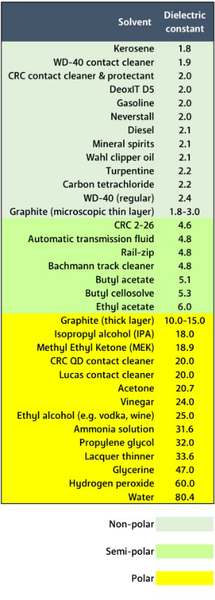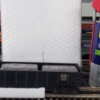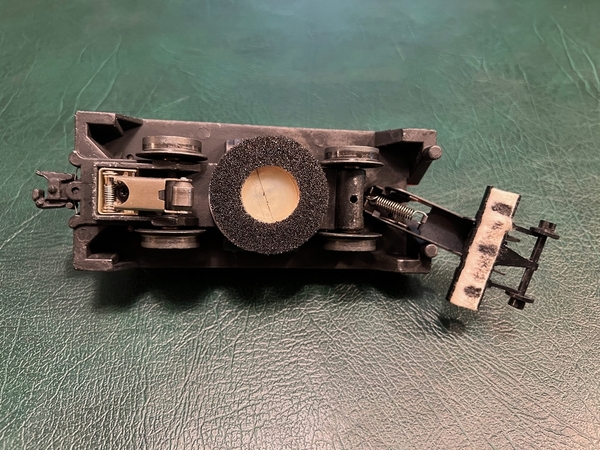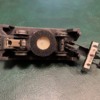Has anyone had experience using WD-40 to clean your track? I used it and it improved electrical contact alot. I wiped the track with a clean cloth after and the trains seem to run better than ever.
Replies sorted oldest to newest
@Chessie posted:Has anyone had experience using WD-40 to clean your track? I used it and it improved electrical contact alot. I wiped the track with a clean cloth after and the trains seem to run better than ever.
Thanks for your comments but there are many, many, many, many, many previous posts in the OGR forum on how to clean track and what to use to do so.
Unfortunately from those posts it appears that WD-40 is considered both good and bad at the same time.
I encourage you to simply add your observations to one of these older threads instead of starting a brand new one. While you're at it why not read through the old suggestions, and add your two-cents to those postings that mirror your recent positive findings. It'll help build a better case for your claim.
Check them out.
Mike
See this thread.
@Chessie posted:Has anyone had experience using WD-40 to clean your track? I used it and it improved electrical contact alot. I wiped the track with a clean cloth after and the trains seem to run better than ever.
FYI - the WD in WD40 stands for Water Displacement. and WD40 is primarily naptha around 65% +/- and paraffins (paraffin is a wax, another 15% +/-
for a long time i heard it was mostly kerosene, it's not.
Don't use WD40 Bad idea. I use Isopropyl Alcohol.
Thanks for all the good info. I did search for WD40 but the search feature of the forum did not yield anything.
@eddie g posted:Don't use WD40 Bad idea. I use Isopropyl Alcohol.
Isopropyl Alcohol has a Dielectric constant of 18.0, very high which makes it not very good.
WD-40 has a Dielectric Constant of 2.4, this makes it one of the better ones to use since you want the Dielectric Constant to be as low as possible.
Attachments
@Mellow Hudson Mike posted:Thanks for your comments but there are many, many, many, many, many previous posts in the OGR forum on how to clean track and what to use to do so.
Unfortunately from those posts it appears that WD-40 is considered both good and bad at the same time.
I encourage you to simply add your observations to one of these older threads instead of starting a brand new one. While you're at it why not read through the old suggestions, and add your two-cents to those postings that mirror your recent positive findings. It'll help build a better case for your claim.
Check them out.
Mike
Man tough crowd. The search feature of this forum sucks big time. Perhaps you could help the man out and post a link to these threads like NJ Joe did. And by the way there’s no issues starting a new thread, he’s not hurting anything by doing so.![]()
“The WD 40 trick will solve this problem. It happens as a result of poor conductivity between the electrical pickups (both collectors and outside rail wheels) and the constant voltage PCB.. Mike”From Mike Reagan in reference to flickering caboose lights. Probably has bearing upon cleaning track, too.
WD40 is like putting oil on the tracks.
WD40 is a cleaner. Not really a lubricant. If you use it be sure to shake the can well as it separates. Myself I'd probably use mineral spirits.
Link to WD-40 product origin story:
Also-
The low dilectric constant is kinda 'advanced maths and science lab' for some folks, but Darrell is correct - the lower this number is, the less available capacitance and/ or potential for arcing/sparking 👍
I have used CRC contact cleaner to clean gargraves and tinplate track with good results.
I have used WD40 for many years with great success on my home layout and on our club's modular layout as well. My method is to apply WD40 lightly to a a manageable piece of cotton. I use my old white handkerchiefs, simply refolding to clean material (my old work socks work well also). Your fingertips can apply pressure on all three rails this way. I wipe down about four to six feet of track at a time and immediately follow up with a dry, clean wipe using the same or another cloth. AND repeat the dry wipe until it wipes clean, usually two or three swipes. The idea is to not leave any residue on the rail to cause damage to rubber traction tires. It is quick and easy. I only have to do this every couple of months. I do however occasionally just wipe down the track with a clean dry cloth while walking around the layout during quiet times during open houses when I have noting else to do.
Best to access MSDS, (Material Safety Data Sheets) for both lacquer thinner, and WD40. At the least there should be instructions/precautions on the can(s).
The Key is to wipe clean and dry thoroughly after using the WD40. Never had a problem.
@Darrell posted:
DARRELL,
Where does "GOO GONE" fit into your "CHART"?
FREDSTRAINS
I have a different take, I don't want any film, grease or what ever on my track that will attract, dust, dirt, cat hair, or what have you. I'm not looking for better conductivity, I'm looking for clean dry track. I use Isopropyl Alcohol 99% I get from work. My track is clean, dry, and I get good traction with my engines and my engines still pick up power from the track just fine. But with that said, do what works with you.![]()
@Fredstrains posted:DARRELL,
Where does "GOO GONE" fit into your "CHART"?
FREDSTRAINS
It has petroleum distillates Which would make it non-polar, but it also has citrus terpenes, of which I have no clue what that is, but if that is like lacquer thinner then that part is polar. So depending on it's exact makeup, my guess is that it is semi-polar.
After looking up the SDS, I would have to say it is non-polar. So it might be great for cleaning the track, but if not completely wiped off the rails it could have a negative effect on traction tires.
WD-40, when it dries, leaves a film. Whether that is good or bad, I don't know, but I would never use it to clean my track. Gun owners all know to never clean gun metal with it, unless you want to see a dry film on it later, which is bad.
The purpose of cleaning a track is to get rid of grease, oil and dirt. 92% isopropyl alcohol does a great job.
Now, if you have a layer of rust on your tracks, then by all means, scrub it with WD-40 to get the rust off. But then, clean off the WD 40 with alcohol.
If after this, you have connectivity problems, then there is a product made especially for this, called NO-OX-ID. I have used it and it worked great. All of the flickering in lighted cars immediately went away.
Mannyrock
WD40 can be an excellent work bench cleaning agent for removing years of built-up crud. However it is also quite flammable, so it must be used with great caution. A momentary lapse can easily result in a singed eyebrow.
Good to hear you chime in Manny......it's been a while since I've seen you post.
Peter....Buco Australia
Thanks Buco. Good'on'ya
My layout is totally finished, with no additional table -top room to expand or add anything anywhere. And, I absolutely hate doing scenery. (I only enjoy the track work.) So, after sticking down a few trees on it here and there, I've been at a dead-end for the last year. I did add a couple of werewolves running around in the trees. :-)
I am happy to be able to add comments on this board if something hits my areas of expertise or experience. WD-40 and structure adhesives are among them.
I still enjoy reading all of the postings, because I always learn alot.
Mannyrock
Many use mineral spirits to clean track and NO OX conducting grease to improve train operation, especially for slow operation with conventional control and to eliminate track cleaning FOREVER. I am at one year, 8 months and counting since applying. See post below for details on post 79.
https://ogrforum.ogaugerr.com/...ra-027-layout?page=8
Charlie
Yep Choo Choo, mineral spirits also works great. But, I found that the fumes can get to you if you are in a basement and have alot of track to clean. And, I have to wear nitril gloves or it burns my hands.
Mannyrock
I second the recommendation of NoOx. I have not had to clean wheels in about 9 months. It takes a little time to apply but worth the effort.
Marty
I usually dampen a melamine sponge, throw it on the tracks and put a gondola on top of it with 3 pounds of lead weights in it... works for me. I've had equally good results with 99% Isopropyl alcohol.
Attachments
Geez, you guys. It's funny how track cleaning and whether WD40 is a good track cleaner, comes up so often. Then there's everyone's analysis, Dielectric Contants charts, surveys, Master's thesis, Doctoral dissertations, etc. ![]()
I'm with Gary on this one. All I want is a clean, dry track to run the trains on. What ever happened to just using good ol' Lionel Track Clean, which is alcohol-based, and the old fashioned track cleaning car? For my Fastback, it's worked well on my layout twice a year for 11 years now. Cleaning model train track isn't exactly rocket science, is it? But, to each his own. 🤔












